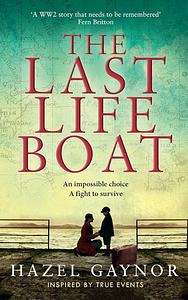Take a photo of a barcode or cover
emotional
hopeful
sad
medium-paced
Plot or Character Driven:
A mix
Strong character development:
Yes
Loveable characters:
Yes
Diverse cast of characters:
Yes
Flaws of characters a main focus:
No
adventurous
emotional
informative
sad
tense
medium-paced
adventurous
emotional
hopeful
informative
sad
medium-paced
emotional
informative
inspiring
medium-paced
Plot or Character Driven:
A mix
Strong character development:
No
Loveable characters:
Yes
Diverse cast of characters:
No
Flaws of characters a main focus:
No
challenging
emotional
inspiring
sad
tense
fast-paced
Plot or Character Driven:
A mix
Strong character development:
Yes
Loveable characters:
Yes
Diverse cast of characters:
Yes
Flaws of characters a main focus:
No
emotional
hopeful
informative
inspiring
medium-paced
Plot or Character Driven:
A mix
Strong character development:
Yes
Loveable characters:
Yes
I couldn't put The Last Lifeboat down. It is beautiful, heartbreaking, and absolutely wonderful. I have waited to attempt a review because I couldn't come up with the words to do it justice, and I still can't.
The Last Lifeboat is told in two POVs, a mother of two children that were evacuated from England and a young woman that is a chaperone on the children's evacuation ship. It shows the sacrifices that people made during the war, and the strength they had when it would be so easy to just give up.
The Last Lifeboat reminded me a lot of The Nightingale. I highly recommend The Last Lifeboat to historical fiction fans, specifically those that enjoy WWII novels.
Thank you to Berkeley for the ARC in exchange for my honest review.
The Last Lifeboat is told in two POVs, a mother of two children that were evacuated from England and a young woman that is a chaperone on the children's evacuation ship. It shows the sacrifices that people made during the war, and the strength they had when it would be so easy to just give up.
The Last Lifeboat reminded me a lot of The Nightingale. I highly recommend The Last Lifeboat to historical fiction fans, specifically those that enjoy WWII novels.
Thank you to Berkeley for the ARC in exchange for my honest review.
A massive long-time fan of Author Hazel Gaynor, all her novels are captivating, and her latest wartime historical novel, THE LAST LIFEBOAT is awe-inspiring and a work of art.
Inspired by a true story, a young teacher evacuates children to safety across perilous waters in a moving, emotional tale that lingers long after the book ends.
1940, Kent: Alice King is a teacher, and she finds safety through the pages of books. But she wants to do her part and volunteers to help evacuate Britain's children overseas. She has no clue what courage she must possess to save herself and the children as they fight for survival.
1940, London: Lily Nichols once dreamed of using her mathematical talents; however, she is happy being a wife and mother of two.
However, when war makes its way through London and her husband is torn away, she must make the toughest decision of her life. Should she keep her son and daughter with her and try to protect them or enroll them in the evacuation program, which they say will be safe, and send them far away on a boat with strangers? The worst nightmare comes true when she learns the boat is unsafe, and they are hit. She feels helpless and distraught.
When Nazis torpedo the S. S. Carlisle carrying a ship of children to Canada, a single lifeboat is left adrift in the storm-tossed Atlantic. Alice and Lily, are strangers to each other—one another's only hope as the two storylines are entwined.
As many of you have read other stories and retellings regarding the FIRST WAVE of mass evacuation from Britain to the countryside for safety during the outbreak of the war during the 1939 Operation Pied Piper (war with Germany) with recent books such as Patti Callahan Henry's The Secret Book of Flora Lea and Julia Kelly's The Lost English Girl. (I highly recommend both-5 stars).
However, very little has been written about the SECOND WAVE of mass evacuation and the "seavacuees": who not only left their families and homes but left Britain when it was believed Hitler would invade and the nightly terror of the Blitz bombing.
Meticulously researched, emotional and suspenseful, this is where Gaynor sets her story with Lily and Alice —historical fiction based on a true story from the torpedoing of The City of Benares in September 1940.
Gaynor's characters were inspired by the accounts of those aboard the City of Benares and are fictional. Included in the author's notes, Alice was inspired by Mary Cornish, a music teacher who was the only woman in Lifeboat 12 and took responsibility for the six children's welfare. She received awards for her courage. She also tells of the other characters' inspiration.
She mentions Lily is drawn from her imagination. She explores eloquently the impact of a tragedy not from only the POV of those on board the ship and those in the lost lifeboat but of those back home in England from a mother's perspective and the horrors faced by parents during the war.
The SS Carlisle no sooner loses its convoy when torpedoed and sinks. Alice, six children, and a few men enter a lifeboat. Alice has to work hard to keep them distracted from the hours they have been adrift in horrible weather conditions. Everything is strange to them, and they have no parents to comfort them. When will they be rescued?
The supplies are nearly gone, and they are unsure they will be rescued. Meanwhile, Lily has been told her son did not survive, and she demands answers. She feels helpless.
Character-driven, I enjoyed Elsie and Peter's diary entries and the letters. I loved the Epilogue, which provides hope over tragedy. THE LAST LIFEBOAT is a must-read and one of the top historical fiction books of 2023! An idea book club pick for further discussions. Historical notes, Discussion questions, and Book Recommendations are included.
This is my eighth book by Gaynor, and each one is utterly spellbinding! Highly recommend all her books. I do not read many historical novels; however, Hazel Gaynor is one of my favorites.
Thanks to #BerkleyPub for an ARC via @NetGalley in exchange for an honest review. Also, an auto-pre-order audiobook narrated by Billie Fulford-Brown.
Blog review posted @
JudithDCollins.com
@JudithDCollins | #JDCMustReadBooks
Pub Date: June 13, 2023
My Rating: 5 Stars
June 2023 Must-Read Books
Top Historical Books of 2023
Facts:
Three thousand one hundred children were sent to Australia, Canada, New Zealand, and South Africa under the Children's Overseas Reception Board (CORB) scheme between July and Sept 1940.
SS City of Benares, carrying 90 CORB children, was stuck by a torpedo fired from a German submarine in the Atlantic Ocean just after 10 pm on Sep 17, 1940. They thought they would be safe—known as the limit of convoy escort. The third torpedo fired at the City of Benares struck the fatal blow. The ship sank within 30 minutes.
Only seven CORB children were initially rescued by HMS Hurricane. It reached the survivors sixteen hours after their ordeal began. Many who had survived the torpedo strike making it to a lifeboat perished in the horrendous weather conditions. A torpedo struck a second vessel, and one of the lifeboats was mistaken for another, thinking all had been accounted for. Eight days later was found, and six more CORB children survived. The special rescue ships had saved over 4K lives by the war's end.
Inspired by a true story, a young teacher evacuates children to safety across perilous waters in a moving, emotional tale that lingers long after the book ends.
1940, Kent: Alice King is a teacher, and she finds safety through the pages of books. But she wants to do her part and volunteers to help evacuate Britain's children overseas. She has no clue what courage she must possess to save herself and the children as they fight for survival.
1940, London: Lily Nichols once dreamed of using her mathematical talents; however, she is happy being a wife and mother of two.
However, when war makes its way through London and her husband is torn away, she must make the toughest decision of her life. Should she keep her son and daughter with her and try to protect them or enroll them in the evacuation program, which they say will be safe, and send them far away on a boat with strangers? The worst nightmare comes true when she learns the boat is unsafe, and they are hit. She feels helpless and distraught.
When Nazis torpedo the S. S. Carlisle carrying a ship of children to Canada, a single lifeboat is left adrift in the storm-tossed Atlantic. Alice and Lily, are strangers to each other—one another's only hope as the two storylines are entwined.
As many of you have read other stories and retellings regarding the FIRST WAVE of mass evacuation from Britain to the countryside for safety during the outbreak of the war during the 1939 Operation Pied Piper (war with Germany) with recent books such as Patti Callahan Henry's The Secret Book of Flora Lea and Julia Kelly's The Lost English Girl. (I highly recommend both-5 stars).
However, very little has been written about the SECOND WAVE of mass evacuation and the "seavacuees": who not only left their families and homes but left Britain when it was believed Hitler would invade and the nightly terror of the Blitz bombing.
Meticulously researched, emotional and suspenseful, this is where Gaynor sets her story with Lily and Alice —historical fiction based on a true story from the torpedoing of The City of Benares in September 1940.
Gaynor's characters were inspired by the accounts of those aboard the City of Benares and are fictional. Included in the author's notes, Alice was inspired by Mary Cornish, a music teacher who was the only woman in Lifeboat 12 and took responsibility for the six children's welfare. She received awards for her courage. She also tells of the other characters' inspiration.
She mentions Lily is drawn from her imagination. She explores eloquently the impact of a tragedy not from only the POV of those on board the ship and those in the lost lifeboat but of those back home in England from a mother's perspective and the horrors faced by parents during the war.
The SS Carlisle no sooner loses its convoy when torpedoed and sinks. Alice, six children, and a few men enter a lifeboat. Alice has to work hard to keep them distracted from the hours they have been adrift in horrible weather conditions. Everything is strange to them, and they have no parents to comfort them. When will they be rescued?
The supplies are nearly gone, and they are unsure they will be rescued. Meanwhile, Lily has been told her son did not survive, and she demands answers. She feels helpless.
Character-driven, I enjoyed Elsie and Peter's diary entries and the letters. I loved the Epilogue, which provides hope over tragedy. THE LAST LIFEBOAT is a must-read and one of the top historical fiction books of 2023! An idea book club pick for further discussions. Historical notes, Discussion questions, and Book Recommendations are included.
This is my eighth book by Gaynor, and each one is utterly spellbinding! Highly recommend all her books. I do not read many historical novels; however, Hazel Gaynor is one of my favorites.
Thanks to #BerkleyPub for an ARC via @NetGalley in exchange for an honest review. Also, an auto-pre-order audiobook narrated by Billie Fulford-Brown.
Blog review posted @
JudithDCollins.com
@JudithDCollins | #JDCMustReadBooks
Pub Date: June 13, 2023
My Rating: 5 Stars
June 2023 Must-Read Books
Top Historical Books of 2023
Facts:
Three thousand one hundred children were sent to Australia, Canada, New Zealand, and South Africa under the Children's Overseas Reception Board (CORB) scheme between July and Sept 1940.
SS City of Benares, carrying 90 CORB children, was stuck by a torpedo fired from a German submarine in the Atlantic Ocean just after 10 pm on Sep 17, 1940. They thought they would be safe—known as the limit of convoy escort. The third torpedo fired at the City of Benares struck the fatal blow. The ship sank within 30 minutes.
Only seven CORB children were initially rescued by HMS Hurricane. It reached the survivors sixteen hours after their ordeal began. Many who had survived the torpedo strike making it to a lifeboat perished in the horrendous weather conditions. A torpedo struck a second vessel, and one of the lifeboats was mistaken for another, thinking all had been accounted for. Eight days later was found, and six more CORB children survived. The special rescue ships had saved over 4K lives by the war's end.
hopeful
sad
tense
medium-paced
Plot or Character Driven:
Character
Strong character development:
Yes
Loveable characters:
Yes
Diverse cast of characters:
No
Flaws of characters a main focus:
Yes
inspiring
reflective
sad
medium-paced
Plot or Character Driven:
Plot
Strong character development:
Yes
Loveable characters:
Yes
Diverse cast of characters:
No
Flaws of characters a main focus:
No







